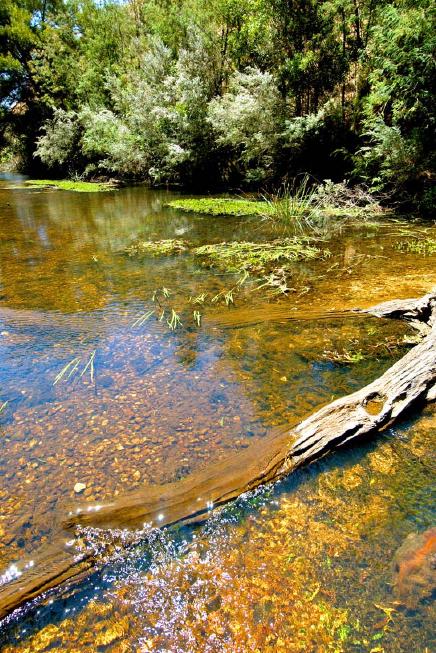Fighting for the Moorabool
Words and Images By Alison Pouliot

Riparian rehabilitation works of the Moorabool Gorge Recovery Program near Morrisons
There has been an ongoing battle over the amount of water being released from Lal Lal Reservoir the dedicated for environmental flows. Among are constantly defenders who fighting to improve its health are 'People for a Living Moorabool' (PALM) who are attempting to increase awareness of the river's poor condition and lobbying for actions to improve its health. Another initiative, The Moorabool Gorge Recovery Program, was established in 2001 to provide incentives for works to improve water quality. Among its many achievements include the protection of over 460 hectares of remnant vegetation, the riparian enhancement of over 48km of waterway and the revegetation of 662 hectares with over half a million seedlings planted (see image). Waterwatch and Landcare groups are also working toward monitoring river condition and initiating programs for environmental improvements. However, for any of these initiatives to succeed, it is absolutely imperative that the river receives its desperately needed environmental flows.
On a broader scale, environmental issue, especially that of water shortage are finally receiving some national focus and attention and it seems that most Australians now consider climate change (which has replaced terrorism!) as the most dire and urgent issue in Australia. 'Water literacy' is the buzz phrase of the last decade which describes this new awareness (of some) about water issues. This goes deeper than reciting rainfall and flow statistics and embodies a more comprehensive understanding of the ecology of connections between rivers, catchments, groundwater, people, history, climate, environment etc.
However, mention the Moorabool River to someone on the street in Melbourne and there's a good chance they won't have heard of it, let alone know where it is, or of its decline. It seems only those living in the near vicinity and directly affected by it are aware of the severity of the problems. Education is always the key and further publicity, education and action are required if the river's environmental values are to be restored. Only through informed and dedicated action is there hope that the Moorabool will one day be removed from the state's most stressed rivers list.
There has been ongoing discussion as to how to effectively convey environmental information to the wider community and how to unite the various communities along the river's length in an effort to fight for the river's integrity. The answers unfortunately are both complex and elusive but creating awareness of the issues with solid information as well as catching people's imagination, enabling them to express their feelings for the river (whether, for example, this be via an arts project or ceremonial activity) are all a part of the process. The aim is simply to get more people informed and involved, to make a connection between the river and the people, to nurture a relationship, to renew kinship with the river.
In addition to acquiring knowledge, creative approaches and rituals can serve as a bridge to connectedness, focusing energy, purpose and obligation towards the river's restoration and maintenance. Whatever the approach, the hope is that through increased understanding and connection, changes in attitudes and behaviour will follow.
The PALM group, local Field Naturalist and Landcare groups along the river's length occasionally hold walks, talks and other events. So if you're interested to see some of the river's dramatic gorges and shady swimming holes, as well as the progress of rehabilitation works, check out the links below.
